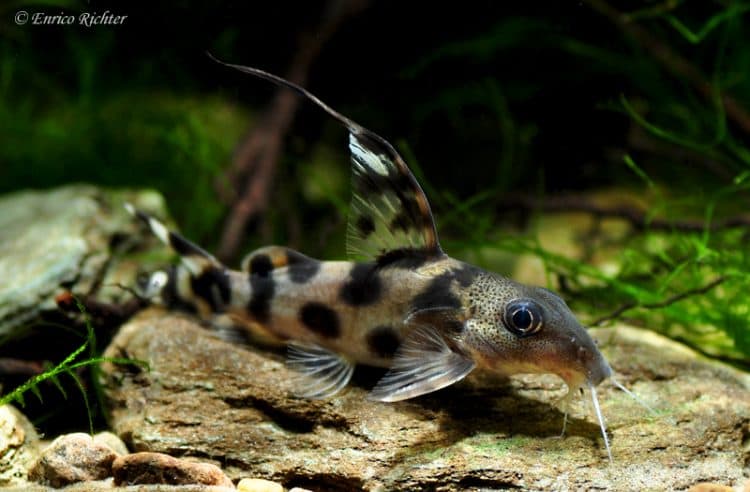- Common Names – Clown squeaker, Clown catfish, Clown Synodontis, Décor-Synodontis, Decorated Synodontis, Barredtailed squeaker.
- Scientific Name – Synodontis decorus. Also known under the synonym names of Synodontis labeo and Synodontis vittatus.
- Natural Distribution – The Congo basin (with the exception of the Luapula River system) of Africa. Many of the wild caught fish in aquaria originate from Cameroon.
Size – 32cm. Can develop a wide body girth.

I remember the awesome sight of my first fully grown clown squeaker, 1981, that was a ‘pet fish’ at Pickhill Aquatics (sadly closed) in North Yorkshire. A couple of years later my first ‘Sid’ arrived and I have kept clown squeakers ever since.
The background body colour of these beautiful fish changes with age from a muddy white in youngsters to light brown in adults. Several large black spots make-up the foreground colouration. The caudal is black-white barred. The caudal of the mail is extended in the form of a thin black membrane that sweeps backwards towards the caudal peduncle. With an ever increasing number of clown squeakers arriving in the U.K. from the commercial breeding of these fish in Eastern Europe we now have variants with a variety of body markings.
Youngsters are available in the hobby at a size of 4cm. These young fish are stronger than they look but may be difficult to get to start feeding (never purchase an emaciated looking clown squeaker). Through research I discovered that youngsters eat a lot of plant material in the wild and, through experience, found that if you have difficulty in feeding decorus of any size vegetable flake is their saviour. Once feeding they relish large sized flake food, catfish pellets, Thai crabstick and will play with algae wafers. Their rate of growth varies between individuals.
Clown squeakers need plenty of room to move around in so I recommend an aquarium of 5’x10″x10″. Decorate with fine gravel, bogwood, large pieces of coal and sturdy plastic plants. Temperature 27 C and a pH of 7. One important aspect of keeping these fish healthy is that they require a much greater volume of air in their aquarium than many other members of their genus do. Filtration can be minimal as long as regular water changes are carried out.
The clown squeaker is not a fish that will hide away. Keep in small groups (although feuding over food items and pecking order can cause minor disruptions) or in the company of other large Synodontis species. For their size these can be placid fish and I have kept them alongside large barbs, rasboras, cichlids, doradids and loricarins.
If conditions in their aquarium are not to their liking or if the water is ready for a change they will let you know by forming a white mucus film on the top of their heads. When conditions return to their liking this film falls away and although at times the area can be a little sore looking, soon heals over. The body of this Synodontis easily scratches. They signal illness, although it is rare to see them with the symptoms of velvet and white spot etc., and old age through a complete draining of body colour.
These fish can become tame and ‘house friendly’. When I moved the fish tanks out of the house and into the fish house, 2003, a large ‘Sid’ was one of many fish moved. He never fully settled and pined for the frenetic movements of a busy household.
Wild caught clown squeakers can live well over 10 years but, sadly, the inbreeding of aquarium stock has greatly shortened this life expectancy.
Please remember that the pectoral spines, although not as sharp as those of a number of fellow Synodontis, can cut through nylon and cause injury to the human hand so we never move a clown squeaker with a net, but lower the water level and coax them into a suitably sized plastic container.
In the wild these fish breed during the rainy season when rivers burst their banks spilling over grasslands. The mature adults, who form distinct pairs, scatter sticky dark coloured eggs over vegetation and the substrate. No egg care. The hatchling fry feed upon micro-organisms and decaying vegetation.
I know of no aquarists in the U.K. who have spawned this species under aquarium conditions. Fish breeders in Poland, using bare tanks and hormone stimulation, were the first to crack the code of reproducing this specie. Sadly they keep their secrets to themselves. Out of interest the Polish breeders used their young clown squeakers as an aquatic currency to barter for other fish species with Russian and Czech aquarists.
As mentioned earlier many of the clown squeakers seen in the U.K. now originate from breeding establishments in Eastern Europe. Shop around as prices vary greatly from one aquatic retail outlet to another.
Leave a Reply